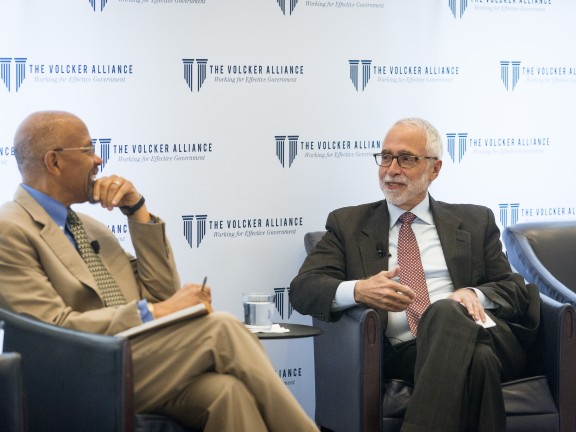New Research Analyzes the Size of Government Since the 1980s

Findings Show Growth and Change in the Federal Government’s Workforce of Civilian, Contract, and Grant Employees
New York, NY (October 5, 2017)—New research published by the Volcker Alliance provides a new level of clarity about the size and composition of the federal government workforce. In two papers released at a press conference at the National Press Club in Washington, DC this morning, Paul C. Light, a Nonresident Senior Fellow with the Volcker Alliance and the Paulette Goddard Professor of Public Service at New York University’s Wagner School of Public Service, demonstrates that the number of federal employees has remained almost constant since 1984. His analysis may come as a surprise to many who assume that the number of federal employees has climbed steadily over time. Prof. Light shows that the storied growth (and the occasional ebb) of the size of the federal workforce over the past four decades is instead largely driven by upticks and reductions in the number of contract and grant employees.
In his paper, The True Size of Government: Tracking Washington’s Blended Workforce, 1984-2015, Prof. Light draws attention to the question of why the federal government turns to contract and grant employees when its staffing needs surge. After convincingly demonstrating that this reliance held true for every administration since Ronald Reagan, despite their overarching policy goals or rhetoric, he details fifteen demographic, bureaucratic, and political pressures that weaken the case for using federal employees to execute federal laws. In addition to a thorough tally of the federal workforce, The True Size of Government digs into the worsening bureaucracy in the layers of government and the resulting pressures responsible for driving this cycle, including:
- skill gaps in mission-critical occupations,
- barriers to federal employee engagement,
- apples-to- oranges pay comparisons,
- weakened internal oversight, and
- the sluggish presidential appointments process.
Commenting on his findings, Prof. Light said, “Americans are so focused on debating the size of government and the need for the 7.3 million people working for the government that we’ve lost track of what I view as a more important issue: are we selecting the right people to implement federal government policy? The number of people working for the government is driven more by concerns of war and peace than it is by the goals an incoming administration may have with respect to policy, cuts, or freezes. What we need is to devote more time to weighing whether the American people are best served by a federal employee or a contractor in each given function.”
One of the political pressures at play in the use of contract and grant employees to meet federal needs is expanded upon in a separate paper by Prof. Light, also released today, People On People On People: The Continued Thickening of Government. The title plays on a remark President Donald J. Trump made on Fox & Friends in March 2017: “You know we have so many people in government, even me, I look at some of the jobs and its people over people over people. … There are hundreds and hundreds of jobs that are totally unnecessary jobs.” Prof. Light agrees that there are a lot of jobs to fill: President John F. Kennedy faced seven cabinet departments with seventeen layers of appointees; President Trump faces fifteen cabinet departments with seventy-one layers of appointees. His research shows that between 1960 and 2016, the layers of government leadership increased from 17 to 71 (318%), while the number of leaders within each rose from 451 to 3,265 (624%). However, Prof. Light said, “Trump is wrong to think he can implement an ambitious agenda without making appointments. He will be left with a neckless government that he cannot control. I would be the first to argue that there are too many layers of government. But, since there are, the most effective strategy for the administration would be to fill the positions, and then conduct a thoughtful and targeted downsizing of the hierarchy.”
Thomas W. Ross, President of the Volcker Alliance, who also delivered opening remarks at the press conference, said “Prof. Light is a superb scholar of the federal government. In these papers, he raises questions that should concern all of us, regardless of political leaning, about what we are asking government to do and how it can operate most effectively. As the recent spate of hurricanes drives home all too clearly, when we need government, we need it to work quickly and nimbly and—most importantly—we need it to work well.” Joe Davidson, Columnist for The Washington Post, led a discussion with Prof. Light about his research and moderated a panel in which they were joined by Danielle Brian, Executive Director of the Project on Government Oversight, and Norman J. Ornstein, Volcker Alliance board member and Resident Scholar at the American Enterprise Institute.

